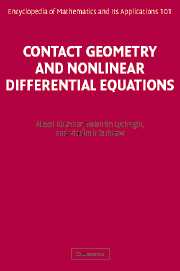The problem of equivalence and classification of Monge–Ampère equations goes back to Sophus Lie's papers from the 1870s and 1880s (see [65, 66, 67]). Sophus Lie have raised the following problem. Find equivalence classes of nonlinear second-order differential equations with respect to the group of contact transformations.
Sophus Lie himself had found conditions to transform a Monge–Ampère equation (MAE) to a quasi-linear one and to a linear equation with constant coefficients. The important steps in a solution of this problem were made by Darboux and Goursat [29], who had basically treated the hyperbolic Monge–Ampère equations.
As far as we know, a complete proof of Lie's theorems had never been published. The first results in this direction were obtained in [73, 74, 77].
In this part we consider the problem of local equivalence for Monge–Ampère equations and Monge–Ampère operators.
In [53, 54, 55, 59, 60, 61] it was shown that for Monge–Ampère equations of general type this problem can be reduced to the equivalence problem for e-structures. This leads to a solution of the equivalence problems and to a classification of Monge–Ampère equations and Monge–Ampère operators.
In this chapter we consider the problem of classification of symplectic Monge–Ampère operators of hyperbolic, elliptic and mixed types.
Let ω1 and ω2 be two effective differential 2-forms on the cotangent bundle T*M.
